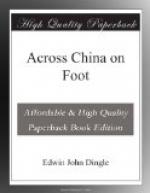Whilst in the end the Empire will profit greatly by the inventions of the Occident, the period of transition in Szech’wan, especially if machines are introduced too rapidly and unwisely, is one that will disturb the peace. It will be interesting to watch the attitude of the people towards the railway, for Szech’wan is essentially the province of the farmer. Szech’wan was one of the provinces where concessions were demanded, and railways had been planned by European syndicates, and where the gentry and students held mass meetings, feverishly declaring that none shall build Chinese lines but the people themselves. I have no space in a work of this nature to go fully into the question of industrialism, railways, and other matters immediately vital to the interests of China, but if the peace of China is to be maintained, it is incumbent upon every foreigner to “go slowly.” Machines of foreign make have before now been scrapped, railways have been pulled up and thrown into the sea, telegraph lines have been torn down and sold, and on every hand among this wonderful people there has always been apparent a distinct hatred to things and ideas foreign. But industrially particularly the benefits of the West are being recognized in Eastern China, and gradually, if foreigners who have to do the pioneering are tactful, trust in the foreign-manufactured machine will spread to Western China, and enlarged industrialism will bring all-round advantages to Western trade.
Thus far there has been little shifting of the population from hamlets and villages to centers of new industries—even in the more forward areas quoted—but when this process begins new elements will enter into the Chinese industrial problem.
As we hear of the New China, so is there a “new people,” a people emboldened by the examples of officials in certain areas to show a friendliness towards progress and innovation. They were not friendly a decade ago. It may, perhaps, be said that this “new people” were born after the Boxer troubles, and in Szech’wan they have a large influence.
Cotton mills, silk filatures, flour and rice mills employing western machinery, modern mining plants and other evidences of how China is coming out of her shell, cause one to rejoice in improved conditions. The animosity occasioned by these inventions that are being so gradually and so surely introduced into every nook and cranny of East and North China is very marked; but on close inspection, and after one has made a study of the subject, one is inclined to feel that it is more or less theoretical. So it is to be hoped it will be in Szech’wan and Far Western China.




